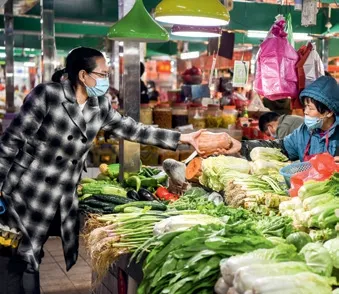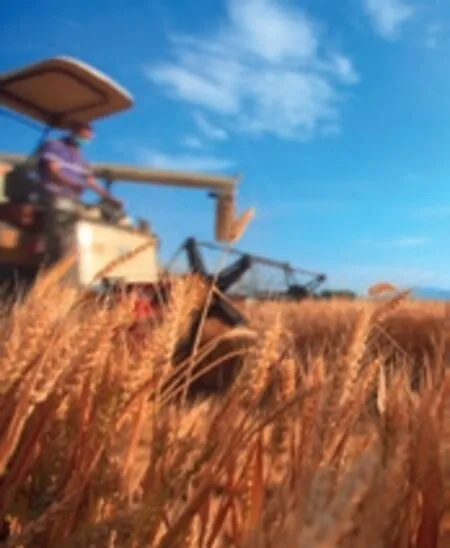Putting the Hand to the Plough
2022-01-12Annualcentralruralworkconferencedesigns2022blueprintByLuYan
Annual central rural work conference designs 2022 blueprint By Lu Yan
With legendary luxuriant black soil, a stretch of farmland in Chenjiadian Village, Jilin Province in northeast China, has been divided into smaller plots, each growing a specific soybean variety.
“These are the new varieties we have developed for farmers to choose from,” Leng Jiantian, a researcher with the Chinese Academy of Sciences, said.Cultivated with advanced technologies, these soybean varieties show many advantages, such as stable and high yields, strong resistance to disease, and sufficient nutrients.
“If we want to grow more grains in the very limited black soil, we must continue to create excellent variations, so that farmers can plant reliable ones that will lift their livelihood,” Leng said.
Ensuring the supply of primary products such as soybean is a major strategic issue discussed at the annual central rural work conference held in Beijing on December 25 and 26, 2021.
The meeting emphasized that the Chinese people’s rice bowl, a metaphor for secure food supply, must remain firmly in their hands at all times, with the rice mainly China-grown.
Securing supplies
The conference analyzed the status quo as well as the agricultural challenges at hand, and mapped out plans for the year ahead.
It called for new efforts in safeguarding grain security and protecting farmland, making structural adjustments, expanding the planting of soybean and oil crops, as well as ensuring the supply of pork, vegetables and other agricultural byproducts.
As rollercoaster food prices exposed the vulnerability of the global food supply chain, supply guarantee has become a priority for many countries, including China. COVID-19 and frequent bouts of extreme weather, as well as an increasingly complex development environment, add to the uncertainty of the global primary product supply chain, Chen Ming, an assistant research fellow with the Institute of Political Science at the Chinese Academy of Social Sciences, held.
“In this context, the conference included foodsecurity and oil supply in its strategic layout of primary product supply, a manifestation of the government’s general goal to seek progress while maintaining stability,” he added.

A resident buys vegetables at a market in Dongxing City, Guangxi Zhuang Autonomous Region,on December 27, 2021
In 2021, China’s grain output reached nearly 683 billion kg, up more than 13.3 billion kg from the previous year, marking the seventh consecutive year that the country’s total grain production exceeded 650 billion kg.
The land for wheat and corn may have expanded, but that for beans has reduced. Total soybean output decreased by 16.4 percent last year to 16.4 million tons, said Wang Minghua,deputy director of the rural affairs department with the National Bureau of Statistics (NBS), as farmers are more willing to plant corn thanks to its growing prices.

A farmer harvests his wheat in Pingyi County, Linyi City, Shandong Province,on June 8, 2021
According to the NBS, in 2021, rice, wheat, and corn accounted for some 31 percent, 20 percent, and 40 percent of the total annual grain output, respectively,while soybean accounted for a mere 2.4 percent. “The demand for soybean in China is huge, and domestic production can meet the request for edible soy products. However, from the perspective of per unit area yield, there is still room for improvement compared with foreign countries,” said Si Wei, Dean of the College of Economics and Management under China Agriculture University (CAU).
Ensuring high-quality arable lands are all used for crop cultivation is yet another key, said Zhu Qizhen,Director of the Institute of Farmer Issues with the CAU.
China’s total arable land shall be no less than 120 million hectares, a red line for farmland capacity and food security as determined by the Central Government. “However, in the past, some farmers would exploit the loopholes in the system and build their houses on fertile land, costing them far less than purchasing an apartment in the city would. Such violations should be stopped in the future,” Zhu told, adding that the best land should be used for increasing yield.
Si believed another key to more bountiful harvests is to improve research and development capabilities.Chinese seed companies still have a lot of options to change for the better, focusing on the research and development of biotechnology which will raise output,increase resilience, and improve climate adaptability.
The conference proposed the formation of 6.67 million hectares of high-standard farmland and the application of agricultural core technologies, all the while developing the rural areas by boosting industries there and accelerating the urban-rural integrated expansion.
At a recent State Council executive meeting,Premier Li Keqiang said efforts should also be made to guarantee the supply of agricultural production materials and the stability of their prices, and offer farmers incentives to improve field management to ensure a bumper summer harvest.
More work to be done
Li called for promoting rural development, improving rural governance and upgrading the rural living environment by continuously improving infrastructure and basic public services there.
China has long been on a quest for better ruralurban integration. Chinese villages are relatively backward compared with the cities, as the country spent decades focusing on urban development. Now,special government attention is going to rural development in the hopes of transforming the countryside into another economic engine, as well as narrowing the rural-urban gap.
“China cannot turn all of the countryside into metropolises and it must pursue a new path to sustainable rural development both economically and environmentally,” Zhu said. He added government incentives and investment should always be a backbone for rural development. “Anyone who wants to contribute to rural progress, such as opening an online produce store or a handicraft workshop in their village, should receive the most suitable policy and financial support,” Zhu noted.
The countryside bears many advantages, such as a beautiful natural scenery, low living cost and easy accessibility to new energy resources via, for example,photovoltaic panels; yet the persistent lack of job opportunities remains a challenge. Measures have been adopted to expand employment channels, such as encouraging the circulation of rural land and the establishment of factory workshops or home-based processing workshops. These workshops managed to create new jobs for a large number of people in such sectors as agricultural product processing, handicraft, farming and breeding, boosting their income. But there’s more work to be done.
Over the past eight years, China has eliminated absolute poverty, and has now shifted its focus to achieve all-round rural vitalization.
The conference urged for more concerted efforts to make sure that there will be no large-scale return to poverty, consolidating the remarkable achievements of the anti-poverty fight.
Minister of Agriculture and Rural Affairs Tang Renjian said China should consistently improve its monitoring mechanism in this regard. Those poverty-prone or experiencing the unexpected should be included in the assistance program and given customized support.
Resettlement zones, where villagers move after leaving the more backward regions, too, should be kept up-to-date. Their surrounding infrastructure, public services and industrial parks all play a vital role in furthering the areas’ employment opportunities and overall quality of life. BR
